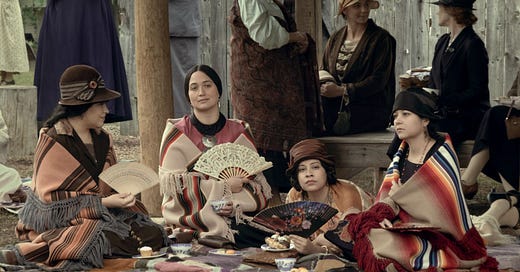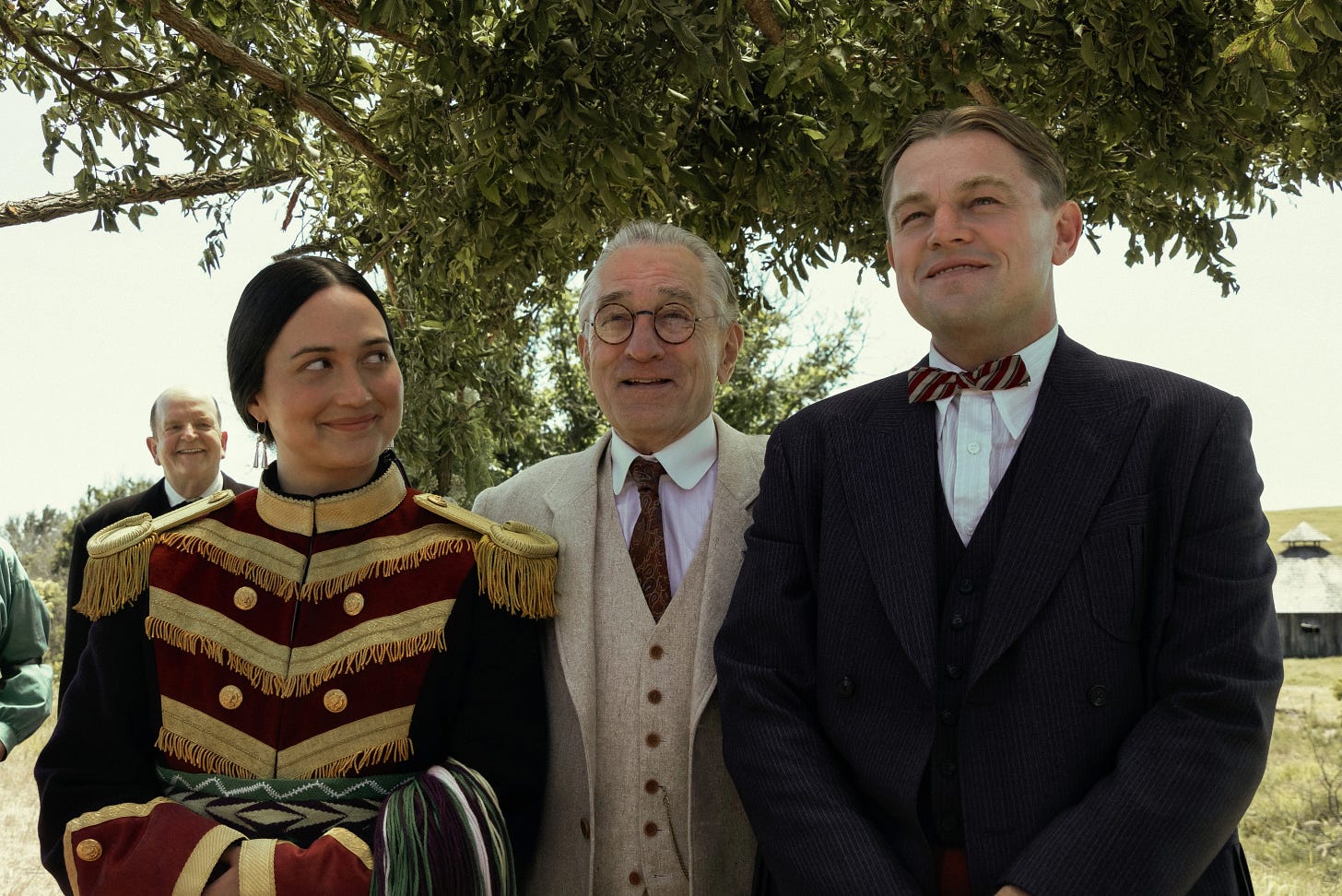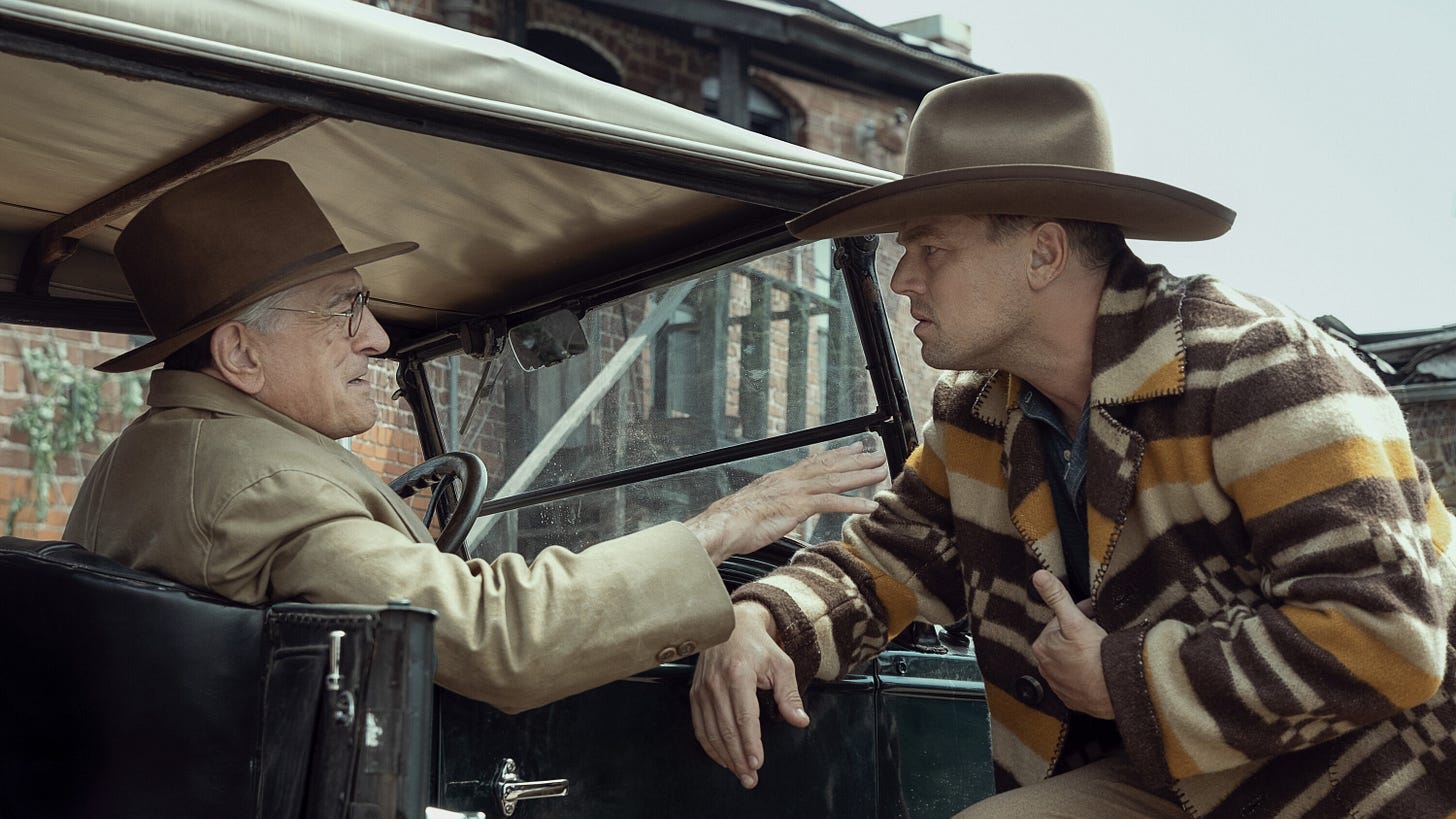The scope of history outweighs the demands of cinematic drama in Martin Scorsese’s newest epic, Killers of the Flower Moon. Based on the non-fiction bestseller by David Grann and adapted by Scorsese and Eric Roth, the film tells the story of a series of murders of Osage people in Oklahoma in the 1920s. This was a time in which the Osage were considered some of the wealthiest people in the world, thanks to reserves of oil that had been discovered on the land to which they had been forcibly resettled by the American government. That same government, though, did what it always does and sought to capitalize on these bountiful resources; so a headright system was developed whereby Osage land was allotted to individuals instead of shared communally. While the Osage people continued to own the land and the profits that arose from it, the parceling of the land was designed to weaken the Osage community and to make it easier for the land rights to be sold to others. The Osage were also appointed (white male) “guardians,” supposedly to protect and handle the Osage people’s wealth, but also, implicitly, to take control of it.
Within this complex and predatory social structure, an operatic drama plays out. World War I veteran Ernest Burkhart (Leonardo DiCaprio) returns to the States and seeks help from his uncle, William Hale (Robert De Niro), who promises to provide work for the young man. Hale deems himself “the King of the Osage Hills”: he’s a businessman and ascending politician who’s made his fortune and amassed his power primarily by killing, cheating, and intimidating others, though he presents himself as a benevolent overseer. Hale is the kind of man who plots to take out a life insurance policy on his “melancholic” Osage associate and murder him in what looks to be an act of suicide, simply to collect an additional $25,000. He’s a version of the villainous land baron from bygone Western movies, chilling precisely because his villainy is utterly believable and based in historical fact.
The character of Ernest is inscrutable from the start, in ways that only occasionally seem purposeful. Dimwitted and seemingly morally vacuous, he admits that he primarily enjoys drinking, gambling, and screwing; if he’s aware of his own place in history and society, he never shows it. This sort of blank-slate pliability makes Ernest an ideal target for his uncle’s manipulations: Hale divulges to Ernest a plot to have his family members marry the women of the Kyle family, comprised of the Osage matriarch Lizzie Q. (Tantoo Cardinal) and Lizzie’s four daughters. By wedding the two families, Hale seeks to take advantage of the headright system and inherit massive amounts of wealth by killing off the Kyle women. The murders are sloppily made to look like alcohol poisoning, suicide, or other incidents, and no one investigates them thoroughly enough to ascertain whether they’re actually murders. Ernest, then, becomes the final piece of Hale’s heartless scheme: by marrying Mollie Kyle (Lily Gladstone) and eventually killing her, Ernest will finally allow the Kyles’ oil rights to be funneled into the Hale family.
Killers of the Flower Moon is filled with commanding (and some histrionic) performances, but none are as important as Gladstone’s and DiCaprio’s. The audience must believe these two people (might) love each other despite the overwhelming social forces against them. (The film, though, does make it clear that intermarriage between Osage and white people was common at this time—a phenomenon bitterly lamented by some characters of both groups.) Mollie is a strong, magnetic character, acutely aware of the injustices that have been committed against her people, so it’s already a challenge to make the audience believe that she might consider marrying the charming but spineless Ernest. He, meanwhile, must have a kernel of humanity in him in order for us to be affected by the horror he perpetuates. To the extent that Killers of the Flower Moon works on a dramatic level, it’s largely thanks to these two performers.
There are many ways this sprawling story could be told. The Grann book on which the film is based primarily focuses on the FBI investigation into the Osage murders, which comes about only after Mollie visits Washington, DC, and lobbies the Bureau of Indian Affairs to become involved. While the initial script mirrored this structure, DiCaprio pushed for the story to be rewritten to focus more on the Osage people and the character of Ernest. In the final version of the film, the FBI story is really only introduced in the last forty minutes or so, with Jesse Plemons playing the role of investigator Tom White (which was originally meant for DiCaprio). The perspective, in other words, is split between that of the Osage people and that of the white family who are responsible for much of the treachery—a balance that doesn’t always work. The film also has elements of a courtroom drama, a tragic romance, a historical thriller, even a self-reflexive commentary on the role of the media in depicting real-world atrocities. This heterogeneous nature undoubtedly makes the movie interesting and accounts for its 206-minute running time, but the film would have benefitted from some judicious editing; a sharper focus might have made Killers of the Flower Moon even more dramatically and thematically potent. (This is especially true of the courtroom scenes, which introduce out-of-place actors like Brendan Fraser and John Lithgow and come dangerously close to Oscar-bait territory.)
Much has been made of Scorsese’s attempts to include the Osage people along every step of the filmmaking process and sensitively depict the historical tragedies that they’ve suffered. I think the attempt is commendable and mostly successful, though questions about identity and representation will always be prevalent when white artists (even someone as colossal as Scorsese) tell stories about marginalized populations. (My belief has always been that an artist should have the freedom to depict characters from other communities as long as they do so sensitively, with radical empathy—though I recognize that’s easy for me, a white male writer, to say.) Not surprisingly, I think Gladstone herself has the most clear-eyed view on the subject: “Marty is a titan, but he’s not bigger than history. He’s a major shaper of it though. It’s the tricky nature of a story like this. You have more representation, but coming from somebody who’s not from the community. So you always have to look at it with a different angle. And there’s nothing wrong with that; you just have to be very aware of the film that you’re watching and what lens it was made through.”
There are moments in which Scorsese’s and the film’s respect and compassion for the Osage people are overwhelmingly powerful. Several of them come near the end, in an unexpected cameo from Scorsese and a single, majestic aerial shot that leaps forward to the present day. And yet, Killers of the Flower Moon isn’t free from criticism in this respect. The Osage critic Robert Warrior rightly critiques the film for failing to include the FBI and the US government in its denunciation: as the movie would have it, William Hale and his circle of conspirators are responsible for this historical outrage, though it was in fact a product of the government’s betrayal of Native American groups stretching back centuries beforehand. (As Warrior writes, this story “arose in the context of the grinding reality of federal Indian policy, which, from the 1880s through the 1940s, proliferated avenues through which Native peoples would lose their land and resources more and more easily.”) Indigenous commentators have raised other concerns about the film, including the Mohawk actor Devery Jacobs, who called the film “painful, grueling, unrelenting and unnecessarily graphic. . . . By showing more murdered Native women on screen, it normalizes the violence committed against us and further dehumanizes our people.”
The film is arguably more interesting (though still flawed) when it focuses on the character of Ernest. This is a man who genuinely seems to love his wife even as he flings himself into a murderous conspiracy to steal her wealth and weaken her people. DiCaprio powerfully exudes Ernest’s torment as he makes secretive deals to murder Mollie’s siblings and injects her with “insulin” shots he almost certainly knows are poison. On the one hand, this is something of a dramatic weakness: we never know exactly how Ernest feels, and his mercurial behavior sometimes seems to shift at the demands of the storytelling. On the other hand, this is one of Killers of the Flower Moon’s boldest thematic points: Ernest benefits so enormously from white privilege that he can’t divest himself of it, even as it slowly kills his wife and her family. It’s like a microcosmic version of the US government’s repeated broken treaties with the Native American people, supposedly brokered in good faith but ultimately a path to the consolidation of power. At its best, the mystery of the Ernest character is a harsh denunciation of white supremacy culture: Ernest is only the most obvious expression of a dominant group that silences its own impulses toward compassion and goodness in order to perpetually increase its own dominion.
As with any dense and problematic film about serious real-world issues, Killers of the Flower Moon should be appreciated despite its flaws for igniting a discourse and battling against the erasure of Indigenous people in the United States. (This is the entire point of the last two scenes of the film, which are enormously powerful while other, supposedly dramatic moments sometimes fall flat.) Despite the obligatory inclusion of the Tom White character and his FBI cohorts near the end, the film mostly avoids white savior cliches, ultimately expressing the opposite: whiteness here is largely associated with destruction and duplicity. Killers of the Flower Moon also strives to correct some historical stereotypes—for example, by depicting a wealthy, cohesive Osage culture that employed white immigrant laborers—and connects the crimes committed against the Osage with the larger history of racial violence in America, as made clear by silent newsreel footage of the Tulsa race riots in 1921. Scorsese is a storyteller first but a historian second, and Killers of the Flower Moon is as vivid in its historical setting as, for example, The Age of Innocence (1993) and Hugo (2011).
For a filmmaker who so often creates astonishing momentum through pure cinematic form (as evidenced by the thrilling last act of GoodFellas), Scorsese sometimes allows the pacing to drag in Killers of the Flower Moon’s middle hour. At times, the movie feels like a succession of events without much attention paid to rhythm, tempo, or cohesion, despite Robbie Robertson’s almost constant score, which creatively welds thumping bass, Native-influenced percussion, and blues riffs. (Special mention should be made of Robertson, the part-Mohawk, part-Cayuga musician who was a member of the Band and who collaborated with Scorsese numerous times after the rock documentary The Last Waltz in 1978; Robertson died shortly before Killers of the Flower Moon was released, but his score is one of its most powerful aspects.) In some ways, Killers of the Flower Moon lacks the visceral exhilaration of some of Scorsese’s work: most scenes consist of wide establishing shots or medium two-shots during conversation scenes, and there’s little of the editing panache we sometimes see from Thelma Schoonmaker, Scorsese’s longtime collaborator. Of course, as always with Scorsese, there are still some jaw-dropping stylistic moments: an early slow-motion dance among spewing oil, for example, or an epic zoom-in on De Niro as he stands outside a stable, regarding the horses he owns.
As rich and majestic as Killers of the Flower Moon is, it can’t be called a masterpiece; it’s not as critical in its politics as one might hope, and it can’t sustain dramatic momentum for its entire three-and-a-half-hour running time. But who else besides Scorsese is making movies like this today—epic, challenging, humanist work that grapples with difficult social and historical forces? Whatever its shortcomings, Killers of the Flower Moon breathes life into American cinema, courtesy of one of the last remaining greats of the studio era and his quest to remind us that film isn’t something to passively stream, but something to intimately experience.





